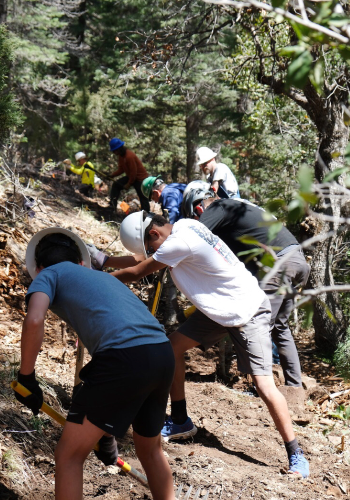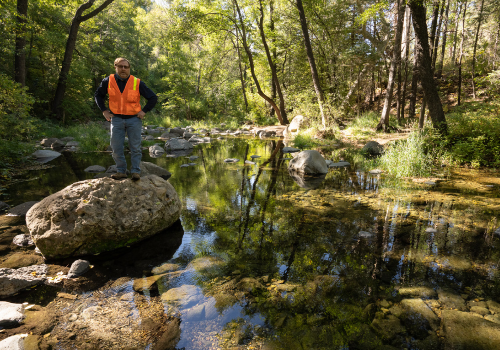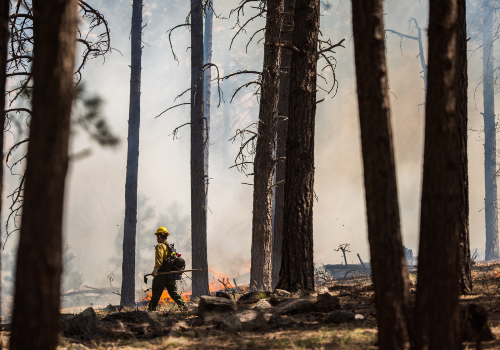BY SASHA STORTZ, REBECCA DAVIDSON, AND JENY DAVIS
In Arizona, the story of people and sustainability most often starts with water. Since time immemorial — long before Arizona was a state — Indigenous people have lived here, thrived, and moved to where water was abundant.
From statehood, Arizona’s growth has been driven by the supply of water, enhancing industry and economy, setting the foundation for life in a diversity of landscapes — from the stark Sonoran Desert cities of Tucson and Phoenix to the verdant forests surrounding Payson, Prescott, and Flagstaff.
Over time, people from near and far understood that water flow in desert communities is directly connected to abundant precipitation in higher- elevation landscapes. The Arizona Territorial Legislature even petitioned Congress in the 1800s to set aside lands in the high country for long-term protection of water supplies for growing communities below. These connections, where snowmelt and rain are absorbed by the land and then drain into a common waterbody like a river, are called watersheds. And these watersheds support water supplies for people and communities across Arizona.
This is a woven landscape of people, watersheds, forests, and deserts. Partners across the state are working together to safeguard water by improving the health of forests, reducing the risk of wildfire, and improving streams, wetlands, and reservoirs across both northern and Southern Arizona.
FROM FOREST TO FAUCET
Have you ever wondered where the water flowing from your kitchen faucet comes from? Or just how the Salt River flows so readily during your tubing adventure? They’re powered by high-elevation snowmelt and rainfall in the watersheds that drain downstream. In the Phoenix Metro area – the fifth largest metropolitan region in the US — water from the Salt and Verde River watersheds support most surface water supplies for 10 Valley cities, which treat that water and deliver it to farms, homes, and businesses, benefitting millions.
With Arizonans’ surface water largely coming from high-elevation forests, it is important to know that a forested watershed with good conditions is one where rain and snow slowly soak into the soil, stream flow is steady, and little sediment erodes downstream. But with declining forest health in the face of drought and overgrown forests, the risk of catastrophic wildfire, impacts of post-fire flooding, and chances of sediment impeding our water supplies are getting worse.
With these pressing challenges, partners across the West are working together to restore forests and watersheds and to sustain vital water supplies.
THE NORTHERN ARIZONA FOREST FUND: A HOLISTIC APPROACH TO WATERSHED PROTECTION
The Northern Arizona Forest Fund (NAFF) is a locally focused initiative developed by the National Forest Foundation (NFF) — a congressionally chartered nonprofit whose mission is to bring people together for the enhancement of National Forests and Grasslands. The NAFF was designed to foster innovative partnership and collaboration for the stewardship of the Salt and Verde watersheds. By providing opportunities for businesses, local governments, and residents of Arizona to invest in the lands they depend on, the NAFF provides a direct link between water users and the health of their water sources.
These investments focus on green infrastructure by enhancing natural systems that contribute to clean and sustainable water flows by reducing fire risk, improving wetlands, and reducing sedimentation into streams and rivers throughout the Salt and Verde watersheds.
By connecting water users and the health of watersheds, NFF works to protect watersheds and forests while engaging funders in a shared responsibility for water resources. Municipalities like the City of Scottsdale and City of Phoenix have been participants in the NAFF since the program’s inception in 2015. Other major partners include the Salt River Project and Sedona’s Pink Jeep Tours.

GET YOUR HANDS IN THE DIRT!
Since the NAFF was established in 2015, NFF has restored over 27,000 acres of forests and 3,020 acres of riparian areas, along with over 325 miles of trails — all part of a multitude of treatments to strategically address high-priority areas of these watersheds.
WILDFIRE AND FLOOD RISK REDUCTION
Through efforts like forest thinning and prescribed burns, the NFF restores forests to be more resilient to severe wildfires. This both protects the forest and reduces the risk of post-fire flooding and sediment flows to local communities and downstream water users. One example is the Pine Canyon Restoration Project on the Tonto National Forest. This project involves thinning 450 priority acres of unhealthy forest in an area that could burn with devastating consequences: a high severity fire and post-fire flooding would have big impacts both to the community of Pine — whose water supply comes, in part, from Pine Creek — as well as downstream water users who rely on the Verde River watershed.
STREAM AND WETLAND IMPROVEMENT
The NFF works to enhance aquatic habitats by protecting and restoring sensitive meadows that act like sponges for groundwater, restoring native plants, and using techniques that help create healthy floodplains. These activities improve water quality and quantity and support some of the most biodiverse areas in Arizona.

The Little Green Valley Fen is a unique place on the Tonto National Forest. For decades, erosion and degradation have dewatered the wetland. By installing structures to help spread out water and replanting native vegetation, restoring this green gem will provide more than 16 million gallons of enhanced water storage annually.
EROSION CONTROL
Implementing erosion-control measures such as improving unsustainable trails and roads helps limit sediment in Arizona’s waterways, protecting water quality for aquatic species and water users.
In Oak Creek Canyon, hundreds of unauthorized trails spiderweb to the creek, which increases erosion and poses water quality concerns. Alongside the Arizona Dept of Environmental Quality and the Coconino National Forest, the NFF is improving trail sustainability and increasing trash pick-up, all with an eye towards improving water quality in this precious waterway. So far, over 320 unauthorized social trails have been rehabilitated and another 40 improved, reducing sediment into the creek by about 40 tons a year.
BETTER TOGETHER
As we face the challenges of drought and increasing water scarcity, initiatives like the NAFF become ever more critical — and everyone has a role to play! The next time you turn on a tap, remember the journey those drops of water have taken. From the peaks of Northern Arizona, through streams and rivers, to reservoirs and canals, water treatment plants, and finally, to homes and businesses — we rely on healthy forests for sustainable water.

Together, from large businesses to every resident across Arizona, we can all help ensure that the vital connection between forests, watersheds, people, and communities remains strong for generations to come. Learn more at www.nationalforests.org/who-we-are/azforestfund.





